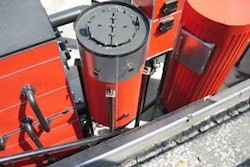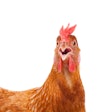
The Czech branch of the World's Poultry Science Association organised the latest international conference on egg production, the 12th European Symposium on the Quality of Eggs and Egg Products, held in Prague. One of the sessions covered recent progress in our knowledge of how egg quality is affected by nutrition, management and environment.
Linseed makes eggs healthier
One of the best western diets for human health is the so-called Mediterranean diet, which is high in fruit, vegetables and fish, and low in saturated fat. The typical Israeli diet appears to lead to more chronic health problems, yet it differs from the typical Mediterranean diet mainly in its relatively high content of omega-6 (n-6) polyunsaturated fatty acids (PUFA) compared to omega-3 (n-3). Dr Niva Shapira of Tel Aviv University presented data from a trial aimed at better balancing the Israeli diet with n-3-enriched eggs.
Hens were fed either a standard, maize diet (control) or one containing 5% extruded linseed (test). Over the 5-week trial period, there were no differences between the groups in terms of production.
There were highly significant differences in egg fatty acid composition. For example, total n-3 PUFA rose to 4.5mg/g with the test diet compared to 1.2mg/g for the control. Omega-3 PUFA alpha-linolenic acid (ALA) increased more than 6-fold and docosahexaenoic acid (DHA) almost 2.5-fold. These changes were observed after just one week of feeding the diets.
The additional cost of the test diet and sensory evaluation of the eggs were not regarded as barriers to the success of the project.
Oilseed cake improves yolk composition
Camelina sativa (also known as false flax; CS) is an oilseed whose cake is not used as a feed ingredient owing to the presence of anti-nutritive factors. However, CS cake has a promising amino acid profile, oil content and a high proportion of healthy' n-3 fatty acids. Eija Valkonen from MTT Agrifood Research Finland presented some research that suggests the material improves yolk fatty acid composition.
CS meal was used to replace up to 100% of the soybean meal in a diet based on barley, wheat and oats. There were no significant differences in laying performance or feed intake over the test period (21 to 69 weeks of age). There were favourable linear increases in egg n-3 fatty acid content, and a reduction in n-6:n-3 ratio, indicating that the eggs are beneficial for human health when CS meal was included in the layer diet. The sensory panel found the eggs to be acceptable.
Aromatic pasture enhancement
With the increasing popularity of free-range egg production in Europe to meet strong consumer demand, researchers have started to turn their attention to the composition of the pasture, and its effects on egg quality. Work into these aspects was presented by Dr E. Sossidou of Aristotle University of Thessalonica in Greece.
Young hens were kept in free-range conditions with access to either grass (control) or the test pasture including aromatic plants (Ocinum basilicum and Menta spicata; members of the basil and mint families, respectively).
Over the 14-week trial period, the test group had significantly higher values for egg weight, albumen weight, yolk weight, yolk colour, shell thickness, egg specific gravity and Haugh units, and a lower value for shell deformation. The differences in egg weight between the two groups were in the order of 2g. The advantages of the aromatic plants were attributed to their stimulating digestion.
Latest on red mite control
Red mites (Dermanyssus gallinae) in poultry houses are an increasing problem. Cage-free egg farms offer more hiding places for mites, and many effective treatments can only be applied when the houses are empty between flocks. Egg collectors are reluctant to enter badly affected houses, and to hens, mites cause irritation, anaemia, reduced egg production and blood spots on the shells. As well as these welfare issues, red mites have recently been identified as vectors for diseases such as salmonella and mycobacteriosis. The economic cost of red mites in Europe has been estimated at 130 million.
With the threat of withdrawal of effective acaricides, Olivier Sparagano of the UK's Newcastle University reported on some emerging methods of control. One vaccine test was successful, illiciting the production of antibodies to the mites, if not significantly reducing their growth. Work continues with recombinant proteins.
A group from Denmark has reported some success using fungi to attack the mites as a form of a biological control. Further work is required to ensure that these fungi can survive in the poultry house and do not harm the birds.
So-called ‘natural' acaricides are mostly based on plant extracts, particularly lavender. Some are effective but the effect may be very short-lived, and possible side-effects on the birds and eggs require further investigation.
IB affects quality
It has been unclear whether the types of infectious bronchitis (IB) viruses that occur in Australia lead to deterioration in the egg and eggshell quality. The first investigations at the University of New England into the effects of two local IB virus strains (T and N1/88) on the oviduct were reported by Dr Julie Roberts.
There were no significant differences in egg production between the experimental groups although the controls had a numerically higher output over the 10-week period. The results confirmed previous findings that IB virus causes thinning of the albumen and indicate that both strains affect the upper reproductive tract. A temporary loss of shell colour was observed between 4 and 8 days post-infection but this was the only clear effect on eggshell quality in this trial. The researchers observed a drop in plasma calcium as well as a difference in egg shape with IB infection.
Session chairman, Dr Maureen Bain, suggested the effect on shell colour may be caused by micro-structural changes in the shell.
Chill during transport
There have been few reports on the effects of transportation on egg quality, a topic covered by Dr Y.M. Yoo of Korea's National Livestock Research Institute. He and his colleagues simulated transportation of eggs for 30 minutes, or 2, 3 or 24 hours at ambient temperature (26°C) or chilled at 7°C. Eggs were weighed and a range of tests on internal egg quality were carried out.
No differences between the treatments were noted for egg weight, yolk colour or aerobic plate counts (as a measure of bacterial contamination on the surface of the egg). However, the researchers recommend chilling eggs during transportation based on the slower declines in Haugh units, albumen height and internal microbial quality compared to ambient temperature that they observed.
Environmental contaminants
Dr Kees Kan of Wageningen University in the Netherlands, presented a thorough review paper on the effects of feed and the environment on the contamination of eggs in the European Union. The good news is that there is generally good control of residues and that overall, the rates are falling.
Pesticide intake through eggs is not considered a problem as typical intake is well below the maximum set. For heavy metals, both the form of the element and interactions with other compounds are important, yet there is little data in this area.
Contamination can be controlled by Hazard Analysis and Critical Control Points (HACCP) analysis for known potential contaminants but not for background ones.
Dioxins in eggs are quite widespread. Sources include PCP (a wood preservative), soil and clay minerals. Related are the polychlorinated biphenyls (PCB) from landfill sites, rivers after flooding and kieselrat, (a by-product of copper production). These materials are picked up by the birds, either in the feed or from the soil. There is evidence of carryover of drugs and anticoccidials from the feed to the yolk, albumen and shell. There is no evidence of higher residues in free-range eggs than from birds kept indoors.
In conclusion, Dr Kan said that free-range poultry are more exposed to infectious agents and chemicals than housed birds. While there are no reports of higher drug residues in free-range eggs, these do contain more dioxins than eggs from housed birds, justifying a risk management programme for outdoor systems.















